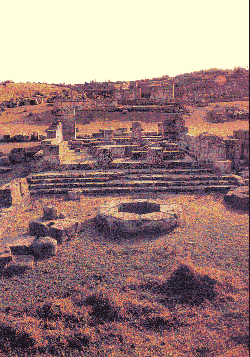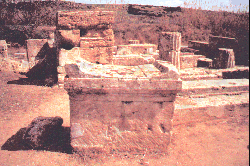 The sacred area, brought to light during tbc excavations
carried out by Cavallari and Patricolo in 1874 - 98 and by Salinas in 1903 -- 1905, was systematically
investigated between 1915 and 1926 by Gabrici, who discovered a huge amount
of archaeological material, currently preserved in the Archaeological
Museum of Palermo. The sacred area, brought to light during tbc excavations
carried out by Cavallari and Patricolo in 1874 - 98 and by Salinas in 1903 -- 1905, was systematically
investigated between 1915 and 1926 by Gabrici, who discovered a huge amount
of archaeological material, currently preserved in the Archaeological
Museum of Palermo.Together with Temple M discovered to the North and the sacred area found to the South, near the mount river, the Shrine of the Malophoros form part of a group of adjoining temene vhich mark the boundary of the city on the western side, to the West of the river Modione, and, in the orientation of the building, follow the main lines of the urban network. The architectural complex of the Molophoros is in fact composed of two sacred areas. Access to the first, the largest and articulated and bound by a high enclosing wall, is gained from a propylaeum whose internal and external facade has two columns and is datable to the middle of the V century B.C.. To the North, the propylaeum is flanked by a pilastered portico which acted as a place of rest for the worshippers, while to the South there is a large area that can be reached from inside the temenos, and which is believed to have been conscerated to Hecate judging from an epigraphic document found nearby. In the higher zone of the sacred area, that is slightly steep towards the East, there is a temple building of a rectangular shape and without a peristasis. Its is divided into three rooms with the entrance to the East. This building was precceded by an older and non longer visible construction, it can be dated to the VI century B.C. and it was restored after 409 B.C. .  In front of
the temple there is a monumental altar, inside which a larage part of the votive material of
the archaic age was found. A small channel runs between the two
monumennts, and this channel crosses the whole
area of the Malophoros and continues beyond the limit of the boundary
wall. It comes from the fountain of the Gaggera, probably inserted
into another temenos, marked by the terraced wall found to the North second sacred
area. This latter, which is smaller, is dedicated to Zeus Meilichios and
to a companion divinity. All that remains of it are the foundations of two
colonnades at the sides of an almost square area with a propylaeum to the
elevation of a small distyle temple close to the western wall. To the
West of this latter, which externally has buttresses at regular
distances, there is an altar with the sacrificial table divied into two
compartments around which numerous artefacts were found together with a
series of stele, some of which without designs and other with human
images. In front of
the temple there is a monumental altar, inside which a larage part of the votive material of
the archaic age was found. A small channel runs between the two
monumennts, and this channel crosses the whole
area of the Malophoros and continues beyond the limit of the boundary
wall. It comes from the fountain of the Gaggera, probably inserted
into another temenos, marked by the terraced wall found to the North second sacred
area. This latter, which is smaller, is dedicated to Zeus Meilichios and
to a companion divinity. All that remains of it are the foundations of two
colonnades at the sides of an almost square area with a propylaeum to the
elevation of a small distyle temple close to the western wall. To the
West of this latter, which externally has buttresses at regular
distances, there is an altar with the sacrificial table divied into two
compartments around which numerous artefacts were found together with a
series of stele, some of which without designs and other with human
images. |


